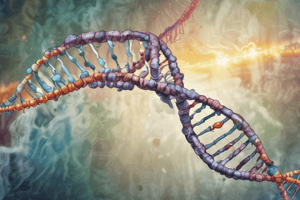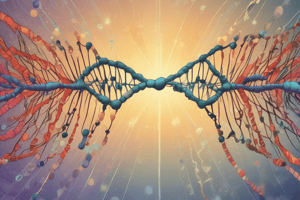Podcast
Questions and Answers
A child inherits a chromosome with an extra segment from an insertional translocation, along with a normal chromosome. Which of the following outcomes is most likely?
A child inherits a chromosome with an extra segment from an insertional translocation, along with a normal chromosome. Which of the following outcomes is most likely?
- The child will experience developmental delays or intellectual disabilities due to unbalanced inheritance. (correct)
- The child will exhibit balanced inheritance, leading to no significant health issues throughout their life.
- The child will have a reduced risk of any health problems compared to their parents, as the genetic material is newly combined.
- The child will be completely healthy, as the presence of a normal chromosome compensates for the extra segment.
An individual is a carrier of a balanced reciprocal translocation. While they are generally healthy, what potential reproductive challenges might they face?
An individual is a carrier of a balanced reciprocal translocation. While they are generally healthy, what potential reproductive challenges might they face?
- No reproductive challenges, as balanced translocations do not affect gamete formation.
- A guaranteed inheritance of the balanced translocation in all offspring, precluding any genetic abnormalities.
- Increased fertility due to the balanced nature of the translocation.
- A higher risk of miscarriages or offspring with unbalanced chromosomal arrangements. (correct)
Which of the following is the most significant implication of understanding the nomenclature used to describe chromosomal abnormalities?
Which of the following is the most significant implication of understanding the nomenclature used to describe chromosomal abnormalities?
- It facilitates precise diagnosis, communication, and management of the condition. (correct)
- It allows for the prediction of future mutations in the same chromosome.
- It helps in determining the exact age at which the abnormality occurred during development.
- It enables the assignment of blame to the parent from whom the abnormality was inherited.
A cytogeneticist identifies an inversion in chromosome 7 in a patient. What immediate concern should be addressed regarding the potential impact of this finding?
A cytogeneticist identifies an inversion in chromosome 7 in a patient. What immediate concern should be addressed regarding the potential impact of this finding?
In an insertional translocation where a segment of chromosome 2 is inserted into chromosome 9, what is the risk to offspring if the carrier parent passes on the normal chromosome 2, the chromosome 9 with the inserted segment, and no other chromosomal abnormalities?
In an insertional translocation where a segment of chromosome 2 is inserted into chromosome 9, what is the risk to offspring if the carrier parent passes on the normal chromosome 2, the chromosome 9 with the inserted segment, and no other chromosomal abnormalities?
During genetic counseling for a couple where one partner is a carrier of an insertional translocation, what critical information should be conveyed regarding the risks to their offspring?
During genetic counseling for a couple where one partner is a carrier of an insertional translocation, what critical information should be conveyed regarding the risks to their offspring?
How does the size of the inserted chromosomal segment in an insertional translocation correlate with the potential health risks in offspring who inherit an unbalanced form of the translocation?
How does the size of the inserted chromosomal segment in an insertional translocation correlate with the potential health risks in offspring who inherit an unbalanced form of the translocation?
In the context of chromosomal structural changes, how do inversions primarily cause difficulties?
In the context of chromosomal structural changes, how do inversions primarily cause difficulties?
If a new deletion is identified on chromosome 15, what is the most critical step in determining its potential impact on an individual's health?
If a new deletion is identified on chromosome 15, what is the most critical step in determining its potential impact on an individual's health?
What distinguishes unbalanced inheritance from balanced inheritance in the context of chromosomal abnormalities?
What distinguishes unbalanced inheritance from balanced inheritance in the context of chromosomal abnormalities?
Flashcards
Translocation
Translocation
Rearrangement of chromosome parts. A segment of one chromosome breaks off and attaches to another.
Inversion
Inversion
A segment of a chromosome is flipped in orientation.
Duplication
Duplication
A portion of the chromosome is repeated.
Deletion
Deletion
Signup and view all the flashcards
Balanced inheritance
Balanced inheritance
Signup and view all the flashcards
Unbalanced inheritance
Unbalanced inheritance
Signup and view all the flashcards
Reciprocal translocations
Reciprocal translocations
Signup and view all the flashcards
Insertional translocations
Insertional translocations
Signup and view all the flashcards
Structural chromosome abnormalities
Structural chromosome abnormalities
Signup and view all the flashcards
Study Notes
- Structural chromosome abnormalities involve alterations in the structure of chromosomes.
- These abnormalities include translocations, inversions, duplications, and deletions.
Translocations
- Rearrangement of chromosome parts.
Inversions
- A segment of a chromosome is flipped in orientation.
Duplications
- A portion of the chromosome is repeated.
Deletions
- A segment of the chromosome is lost or deleted.
Balanced vs. Unbalanced Inheritance
- Balanced inheritance means the total amount of chromosomal material remains the same, with no extra or missing parts, typically resulting in no clinical symptoms.
- Unbalanced inheritance involves inheriting too much or too little chromosomal material, leading to clinical issues like developmental delays or congenital malformations.
Difficulties Arising from Inversions
- Inversions involve a segment of a chromosome breaking off, flipping, and reattaching.
- This can affect how genes are expressed or lead to problems during gamete formation.
- Inherited inversions can cause difficulty in chromosome pairing during meiosis, leading to abnormal gametes and unbalanced inheritance.
Nomenclature of Chromosomal Structures
- Understanding chromosomal abnormality naming conventions is important for precise diagnosis, communication, and treatment.
Chromosomal Structural Changes: Translocations
- Translocations involve the rearrangement of parts of chromosomes, where a segment of one chromosome breaks off and attaches to another.
- Reciprocal translocations involve two chromosomes exchanging pieces, maintaining a balanced overall genetic material, which may still cause fertility or health issues.
- Insertional translocations involve a piece of chromosomal material from one chromosome being inserted into another, leading to more complex inheritance patterns.
Insertional Translocation Example
- A chromosomal segment from chromosome 3 is inserted into chromosome 5.
- Even though the segments are not in the correct order, the person generally has the correct number of genes, so they may not show any symptoms of the translocation.
- Issues arise during reproduction through eggs or sperm and how these chromosomes pair up during fertilization.
Effects of Insertional Translocations
- Most carriers are healthy because they still have the correct number of genes despite the rearrangement.
- Issues can arise when they have children due to the nature of how chromosomes are inherited.
Inheritance Scenarios for Insertional Translocations
- Healthy offspring inherit two healthy chromosomes, without the inserted segment, receiving the correct amount and type of chromosomal material.
- Unbalanced inheritance occurs if the parent passes on the chromosome with the extra segment along with a normal chromosome, leading to too much chromosomal material.
- This can lead to health problems such as developmental delays, intellectual disabilities, or growth problems.
- Unbalanced inheritance occurs if the parent passes on the chromosome with the shortened chromosome (missing the segment) and a normal chromosome, leading to too little chromosomal material.
- This can result in problems similar to those caused by extra material, including developmental delays and other health issues.
- Risk for a child inheriting unbalanced inheritance from a parent carrying an insertional translocation is 50% because each parent contributes one chromosome.
- The larger the insertion, the greater the risk for more significant health problems or even miscarriage.
Summary Points
- Structural chromosome abnormalities can cause various genetic changes, including translocations, inversions, duplications, and deletions.
- The impact on the individual can vary depending on the type of abnormality and how it is inherited.
- The key difference between balanced and unbalanced inheritance is that balanced inheritance doesn't involve the gain or loss of chromosomal material.
- Unbalanced inheritance involves either an extra or missing piece of chromosome material, leading to health problems.
- Insertional translocations can cause unbalanced inheritance depending on whether the child inherits extra or missing chromosomal material, which often leads to developmental delays or other health issues.
- Nomenclature for chromosomal abnormalities helps in identifying, diagnosing, and managing these conditions, particularly in a clinical setting.
- Understanding the complexities of structural changes like translocations and their potential effects on inheritance is critical for genetic counseling and treatment.
Studying That Suits You
Use AI to generate personalized quizzes and flashcards to suit your learning preferences.




